Introduction
With few exceptions, crocodilians must be counted and caught for studies of their ecology. Most methods of finding and catching crocodilians in use today are modifications of methods for harvesting crocodilians (Chabreck 1963; Jones 1966). These methods have been adapted to suit the target species, or local habitat conditions and to minimize risk of injury to the crocodile and the investigator (Webb and Messel 1977; Hutton et al.1987; Walsh 1987; McDaniel and Hord 1990). Any particular situation will likely require innovations on methods used by others.
Finding Crocodilians
Transportation
Crocodiles have to be located before they can be counted or caught. Various techniques are used depending on the habitat, cost, field logistics, and goals of the study. Occasionally one is lucky enough to be able to approach a crocodile by automobile, and sometimes crocodilians can be found via walking surveys. More often because crocodilians live in aquatic environments, some type of water-craft is required. Fixed-wing aircraft and helicopters can be used to find crocodilians in areas not accessible by boat and to cover large areas quickly. Surveys designed to obtain detailed information on demography and habitat use are usually done from boats.
Water-craft used to find crocodilians usually have a shallow draft and an open interior and are made of some combination of fiberglass, wood, aluminum, and plastic. Kayaks, jon boats, canoes, pirogues, marsh skiffs, fishing skiffs of various design, and airboats are used in aquatic habitats; and allterrain amphibious transportation is used to traverse large expanses of dry areas between wet ones (Figure 1).
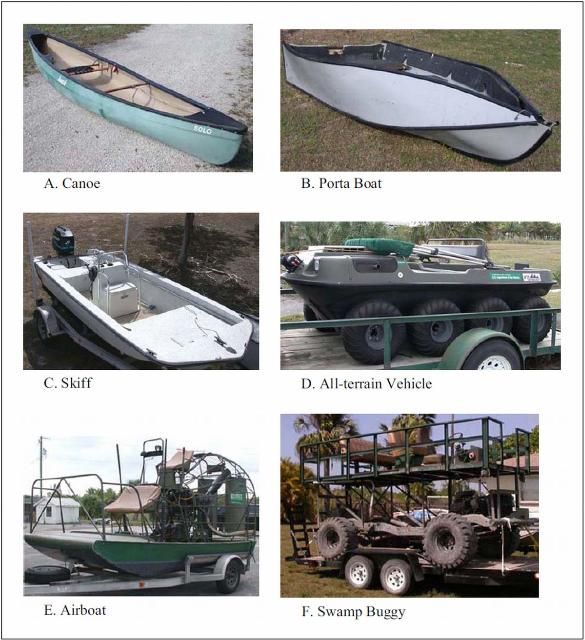
Credit: Michael Cherkiss
The methods of propulsion used are as varied as the craft. Kayaks, jon boats, pirogues, marsh skiffs, and canoes are propelled by paddle, pole, small portable outboard or inboard engines, or electric motors. Fishing skiffs are powered by larger outboard engines, which may or may not be permanently attached. Traditional outboard motors are good in open water areas, and the engines made by Go-Devil Manufacturers of Louisiana, Inc. (www.go-devil.com) are reportedly effective in areas with dense vegetation, mud, stumps, and rocks. Fishing skiffs also can be "poled" over areas that are too shallow for an engine. Airboats have a very shallow draft and flat bottomed hulls made of aluminum or fiberglass. Propellers, similar to those in aircraft, are mounted in a cage at the stern of the boat. Airboats may be powered by aircraft or automobile engines. Specially designed airboats can run in little or no water. On these "marsh" boats, aircraft engines are more effective because they have a better horsepower to weight ratio.
All-terrain transportation is needed when seasonal wetlands dry out periodically leaving crocodilians concentrated in isolated ponds and pools. In the Venezuelan Llanos, investigators generally visit caiman ponds on horseback, although four-wheel-drive allterrain vehicles can be used. In Florida a variety of custom built "swamp-buggies" are used when the ground is exceptionally soft or rocky, or the water is deep. The allterrain amphibious vehicle shown in Figure 1 can be used as a wheeled- or tracked vehicle and is also capable of crossing deep water such as canals. With the tracks in place the vehicle has a soil impact pressure of less than 60g per square centimeter. This is less than the impact of a human footstep and minimizes damage in environmentally sensitive areas.
Navigation
Map and compass skills are necessary to locate and survey the area of interest, and after locating a crocodile you have to find your way home. Sighting and/or capture sites can be marked on a very detailed map, but allow for human error. Global Positioning System (GPS) receivers are especially helpful because locations can be annotated. GPS receivers can provide maps of the area (when downloaded with the appropriate software), show paths, record locations of sightings or captures, record environmental data or other habitat features at a resolution appropriate to the unit for later analysis, and assist in navigation, but they do not replace basic orienteering skills. While PDAs were the first electronic means of data collection, the use of electronic tablets is becoming a more popular method..
Lights
The best time to count or catch crocodilians is at night. This is because crocodilians are more active at night and their eyeshine (light reflected from the tapetum lucidum) makes them visible. For these reasons night eyeshine or spotlight surveys are the preferred method for finding crocodilians (Magnusson 1982). Good lights make a big difference. Halogen and xenon bulbs produce a very bright light. Brighter is not always better; very bright lights will wash out the eyeshine from smaller crocodilians and those that are nearby. Lights in the 50,000 to 200,000 candlepower range are most effective and a blue beam has much less glare than a white one. Marine and dive lights also are good sources of light for crocodile researchers because they withstand wet conditions under which most surveys are conducted. When fabricated spotlights are not available, effective spotlights can be fashioned from an automobile headlight and battery.
Headlamps are as important to a crocodile catcher as spotlights. They are essential when a water-craft is propelled manually and during capture events when one's hands must be free. Many types of headlamps have been designed for mining, hunting, and camping.
Counting Crocodilians
Informants
Interviews and previous data can be helpful upon the initial visit to a site as a method to obtain background information or in determining current research needs (Thorbjarnarson 1988; Thorbjarnarson and Hernandez 1988). Unfortunately, personal communications are often biased, not replicable, and the information may not be current or specific (Magnusson 1982). Regardless of their shortcomings as a survey technique, interviews can be helpful in identifying appropriate areas of research, may provide information that otherwise would not be acquired, and help to build important relationships with the local community.
Artifacts
The most common artifacts left by crocodilians are tracks, nests, and feces. Searching a site for the sign of a crocodilian can be helpful in determining the presence (but not absence) of an animal. Tracks in the substrate can be made by crawling and tail drags. Nests and nesting sites can be located by scanning the shoreline from a boat, airboat, or by foot along canals and creeks. Aerial surveys may also be performed to locate nests (Magnusson et al. 1980; McNease et al. 1994; Brandt et al. 1995). A fourth sign of crocodilian presence is auditory since some crocodilians bellow during breeding season or when they feel threatened. Combining the above methods allows for a more complete coverage of an area (Magnusson et al. 1978) (Figure 2).
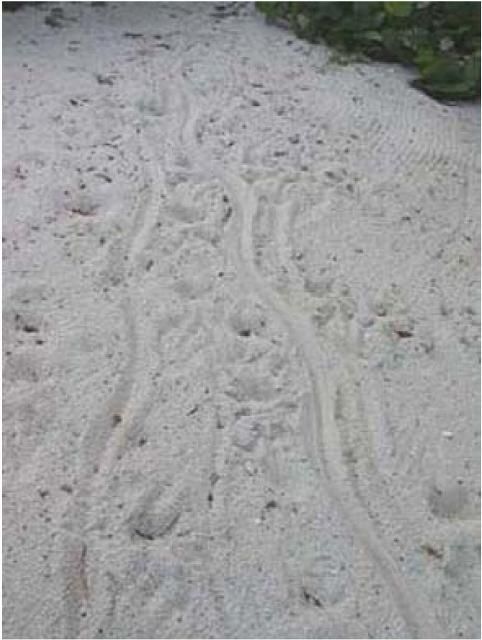
Credit: Michael Cherkiss
Surveys
Daylight Ground Counts
Daylight ground counts require the least equipment and are the most easily arranged. However, many zero-counts have been associated with daylight ground counts, given that crocodilians refrain from basking with cloudy weather or when the optimal body temperature is reached (OBrien 1990). In addition, during late spring many species' diurnal activity decreases and nocturnal activity increases making night surveys more appropriate. Daylight ground counts can be done on foot, from a ground vehicle, or from the air, sometimes reducing transportation and logistical costs (Magnusson 1982).
Daytime Aerial Surveys
Daytime aerial surveys are widely accepted as a cost effective method to survey crocodilian habitat given the immense ground coverage in a limited time (Magnusson 1982; OBrien 1990). Flying can be especially useful in habitats where prop boats are unable to travel or airboats encounter difficulties. Helicopters and fixed-wing planes should fly within 50-80m of the ground to get an adequate count.
Successful counts have been done with helicopters traveling 80-100km/hr and fixedwing aircraft flying at 120km/hr (Kushlan and Mazzotti 1989). Aerial surveys are most effective in open marsh and lake habitats to detect distribution and abundance of crocodilians or nests, and least effective in areas where canopy closure blocks visibility (Magnusson 1982; OBrien 1990).
Night Spotlight Surveys
Night spotlight surveys are the preferred method of crocodilian survey (Magnusson 1982) because of their versatility in habitat and the nocturnal nature of the animals. Spotlighting is usually performed from a water-craft but can be done on land from a vehicle or on foot. Eyeshines allow the researcher to see the animal from great distances and in situations where the animal might not have been otherwise seen (OBrien 1990). This does require the animal's eyes to be above water and submersion can prevent observation. In addition, inconsistent data often result from human error, differences in type of boat or light used, and environmental conditions (Pacheco 1996). Night surveys may be the most costly ground effort but produce the most reliable population data. This technique also allows for gathering environmental data and specific details on the animal and its condition.
Limitations
Factors other than population density affect the number of crocodilians counted during a survey, and not all of the crocodilians in an area will be counted (Graham and Bell 1969; Magnusson et al. 1978; Bayliss 1987). Environmental conditions such as wind, air and water temperature, and wave action affect crocodilian counts (Woodward and Marion 1979). Accessibility and type of habitat (e.g., pond or marsh) also affect the proportion of crocodilians observed, as does the skill of the observer, type of boat, motor (or lack of), and light used. Two observers shining lights independently can estimate potentially visible crocodilians missed (when one observer sees one that the other does not) during surveys (Magnusson et al. 1978; Bayliss 1987). This does not account for crocodilians not seen because they were submerged (out of wariness or other reasons) or that were obscured by vegetation, position, or other habitat feature. Wariness of crocodilians can be estimated by the distance an observer can approach before submergence (Webb and Messel 1979; Pacheco 1996), and visibility in different habitats can be tested by thoroughly searching a sample area in daylight after a typical survey, or by having one crew set out dummy crocodilians to be counted by a survey crew.
Capturing Crocodilians
A challenge in catching and handling crocodilians is their extraordinary range of body sizes. Naive, easily hand-grabbed hatchlings are about 25cm long and weigh about 25g. Wary, unapproachable adults can reach lengths of 5m and weights of 500kg. Captured crocodilians have to be restrained, sampled, marked, and released unharmed. Removing restraints and releasing a large crocodile are the most dangerous aspects of an already hazardous task.
Hunting and trapping are the two basic approaches to catching crocodilians. The decision whether to hunt or trap, and what technique to use depends on many factors: size, wariness, hide toughness of the target species, habitat they occur in, mode of transportation used to find them, and fate after capture. If the crocodilian is to be killed after capture, then methods that may cause mortal wounds can be employed. Because most ecological studies involve live animals, we will with few exceptions (e.g., harvest harpoons and baited hooks) describe methods that are designed for the safety of the crocodilian and the investigator.
Traps
The advantage of trapping is that you have the potential to catch animals too wary to be approached by humans. Trapping is not, however, selective. Animals of all sizes and sexes are captured. In addition, until a trap is checked, a trapped crocodile is at risk of injury from struggling, drowning, overheating, or being attacked (Walsh 1987; Leslie 1997). Checking traps at regular intervals is very important. Transmitters can be rigged to signal when a trap is sprung (Webb and Messel 1977).
A regularly used habitat, such as a trail, nest site, basking site, or den are good sites for setting walk- or swim-through traps to catch the animals. If this is not successful, bait may be needed to attract a crocodilian to the securing device. An advantage for bait is that it can be attached to a triggering device, which hastens the closing of the trap (Murphy and Fendley 1975; Leslie 1997). Counter weights, leaf springs, bamboo, fiberglass poles, and rubber tubing have all been used to spring traps (Pitman 1941; Murphy and Fendley 1975; Webb and Messel 1977; Hutton et al. 1987; Walsh 1987). A disadvantage of using bait is that non-target animals may eat it first. This leaves the trap without bait, either activates or disables the triggering device, and may even trap the wrong animal.
Large baited hooks set over a body of water are effective for catching crocodilians to be killed. Baited digestible hooks can be used for capturing crocodilians to be released. A digestible baited hook is made by running a natural fiber rope (hemp or cotton) through a hollow bird bone (Walsh 1987) or wood dowel and surrounding this device with a chicken carcass, or pig or cow lung. When the bait is swallowed, the dowel or bone becomes lodged inside the stomach, effectively "hooking" the crocodilian. The rope can be cut after the animal is retrieved and the trapping apparatus is then digested. A noose can be baited directly, catching the crocodile around one jaw. This increases the risk of injury over a walk- or swim-through trap, but works well with heavy jawed species (Kofron 1989). When using a triggered device, baited traps, nooses, nets, boxes, or cylinders, securing the device is essential. Box or cylinder traps are unwieldy, and crocodilians readily become trap-shy (Leslie 1997) and can easily hurt themselves while struggling (Walsh 1987). Nooses and nets are effective for large crocodilians, cause minimal injury, and are reusable (Pitman 1941; Murphy and Fendley 1975; Webb and Messel 1977; McDaniel and Hord 1990; Leslie 1997) (Figure 3).
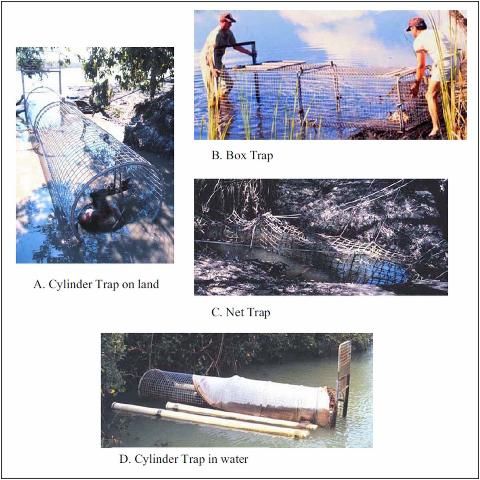
Credit: Graham Webb
Walk-through snares can be set on trails (Mazzotti and Brandt 1988; Wilkinson 1994) (Figure 4), and floating nets can be set across creeks or in ponds (Webb and Messel 1977). Floating nets also catch fish, which can act as bait. Nets must be monitored almost continuously to prevent crocodilians or other animals from being captured and at risk to drowning. Crocodilians in dens or caves can be trapped by setting nooses or nets at the openings. Sometimes the path of the crocodilian can be followed on the surface of the ground by probing into the soil with a metal rod. An investigator can then encourage the animal to leave the den by prodding at the animal. The investigator also can dig down into the den exposing the crocodile for capture. We do not recommend digging up dens because it destroys a critical habitat feature on which other aquatic animals may depend.
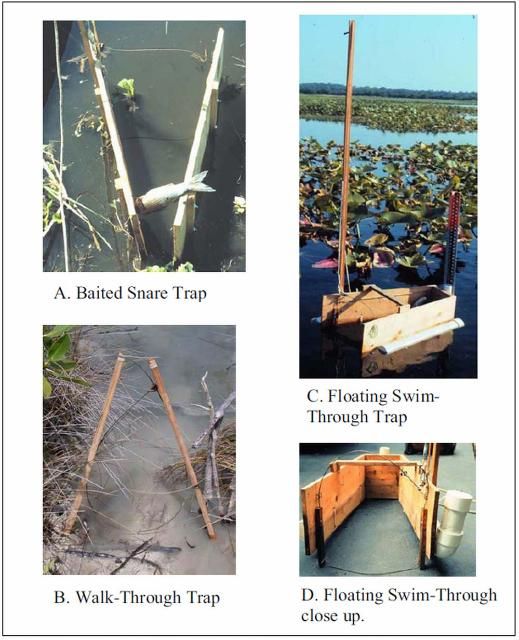
Credit: A. Phil Wilkinson, B. Michael Cherkiss, C. and D. Graham Webb
A basking trap is a modified turtle trap (Petokas and Alexander 1979) and is effective for small wary animals. A floating platform is placed where small crocodilians have been observed basking, and then surrounded by nets. A startled crocodilian will dive off the platform into the nets. Removing alternative basking sites, if possible, encourages the crocodilians to use the basking platform.
Camera trapping does not involve handling animals (Thorbjarnarson et al. 2000). Optical or digital cameras are set in areas of activity (nest sites are particularly productive), and the camera is triggered by heat or motion sensors. The picture is dated and time stamped. The amount and type of data collected is limited to presence and behavior since the animal is not actually handled by the investigator. In addition, this equipment can be costly and therefore requires a secure area for placement.
Hunting Crocodilians
Advantages of hunting crocodilians are that specific animals can be selected for capture. Most crocodilians are captured by this method. Smaller crocodilians (less than 1m total length) are captured by hand, tongs, nooses, small weighted treble hooks, and different types of nets, including dip nets, cast nets, and seine nets. Larger crocodilians are caught by bigger nooses (self-locking wire nooses are best), small harpoons, small treble hooks, and nets.
Handgrab/Tongs
An experienced researcher can grab a smaller animal behind the head or use tongs to extend the arm's reach. Pillstrom tongs are usually used for snakes, but can catch an animal up to 90cm long. Pilstrom tongs are a tubular aluminum pole with a plier attachment on one end and a squeeze mechanism on the other (Figure 5). The plier end clamps on the crocodilian's neck or tail so it can be lifted into a bucket or be grabbed. Hands and tongs are not effective for crocodilians larger than 1.25m, which can easily struggle free and bite the hand that is grasping it. Even 1m crocodilians test the limit of most tongs and must be plucked quickly from the water into a boat or pinned to the substrate to avoid losing or injuring the animal (Webb and Messel 1977).

Credit: Michael Cherkiss
Nets
Crocodilians less than 1.2m total length can be caught with dip nets. Dip nets can be constructed with the net in line with the handle for scooping (Jones 1966), or at an angle to the handle, to press down over the crocodilian from above (Webb and Messel 1977). Cast and seine nets are effective in open water but readily get caught on vegetation or rocks.
Darting
Darts are modified harvest harpoons (Jones 1966; Webb and Messel 1977; McDaniel and Hord 1990) where the size of the penetrating head is reduced so the depth of penetration into the target animal is shallow. Modification reduces the chance of injury to the darted animal. Darts are attached to the end of a pole that is thrust by hand. The dart, attached to a line, then separates from the pole (Figure 6). Accuracy and power are critical components of a successful dart harpooning. Darts should be placed in an area of relatively soft hide away from internal organs. The jowls and sides of the tail are the best places to set the dart. Hitting the right spot from a moving boat can be tricky particularly if the animal is diving. The dart has to be delivered with enough force to penetrate the hide. Short punching strokes provide the best combination of power and accuracy.
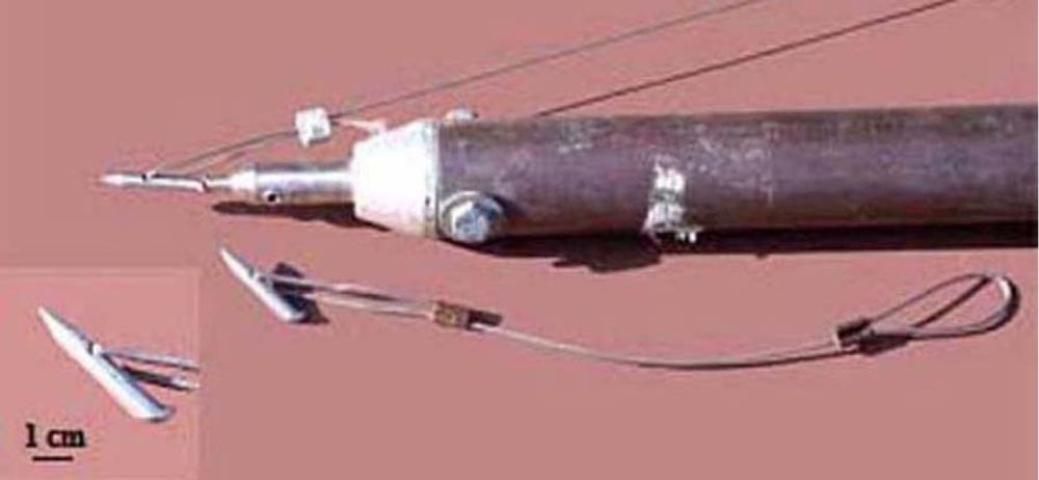
Credit: Michael Cherkiss
Although we have successfully darted animals as small as 1m total length, the safe target area on animals less than 1.5m total length is so small that the risk of injury increases dramatically. Because darts can pull free when an animal struggles, they are used primarily to keep a line on the animal until it can be noosed.
In harvest situations larger hand-thrust harpoons can be used, as can propelling devices. Two popular methods of delivering harpoon heads are hunting bows and spear guns. In catch-and-release situations it is very difficult to propel a dart accurately with enough power to penetrate the hide and not cause injury.
Noosing
Noosing is a common technique and works well when it is possible to approach the animal close enough to place a noose around the animal's neck (Chabreck 1963; Jones 1966; Mazzotti 1983; McDaniel; and Hord 1990). It is best to rig the noose so that it breaks free from the pole preventing an unwieldy device as the crocodile thrashes, and allows the animal to tire itself out prior to being brought on board. The noose is tied to good quality line that is attached to a float or to the catch-boat. Floats should be used when catching large crocodilians from small boats so that the whole rig can be thrown in the water if a crocodile is fighting and threatens to tip over the boat. The animal can be retrieved later. Nooses can be set by pulling or jerking. Researchers hold the line, and after placing the noose around the animal's neck, pull the line quickly, closing the noose. In jerking, the researcher yanks the pole in a manner similar to setting a hook during fishing.
Catch poles can be made from wood, bamboo, fiberglass, plastic, and other materials depending on preference and availability. Poles should be stiff and lightweight; those used for jerking should have a certain amount of flexibility. Telescoping poles can facilitate transport. Nooses are attached to the poles with tape or spring clips (Figure 7).
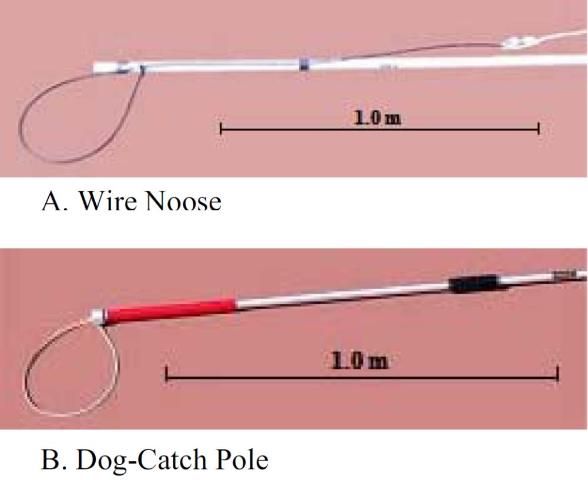
Credit: Michel Cherkiss
Snatch Hooks
Weighted treble hooks can be cast out past a crocodilian to snag the animal during retrieval (McDaniel and Hord 1990) (Figure 8). Crocodilians in ponds that are otherwise inaccessible can be snagged with treble hooks dangled from a maneuvering helicopter. The catcher then jumps into the pond and tows the crocodile to the nearest shore to be processed. A fishing pole can also be used to cast the treble hook out over the back of the crocodilian and hook it into the tail or back. Since hooks can be pulled free and injuries can occur when a crocodile struggles, the animal should be noosed as soon as it is within reach.
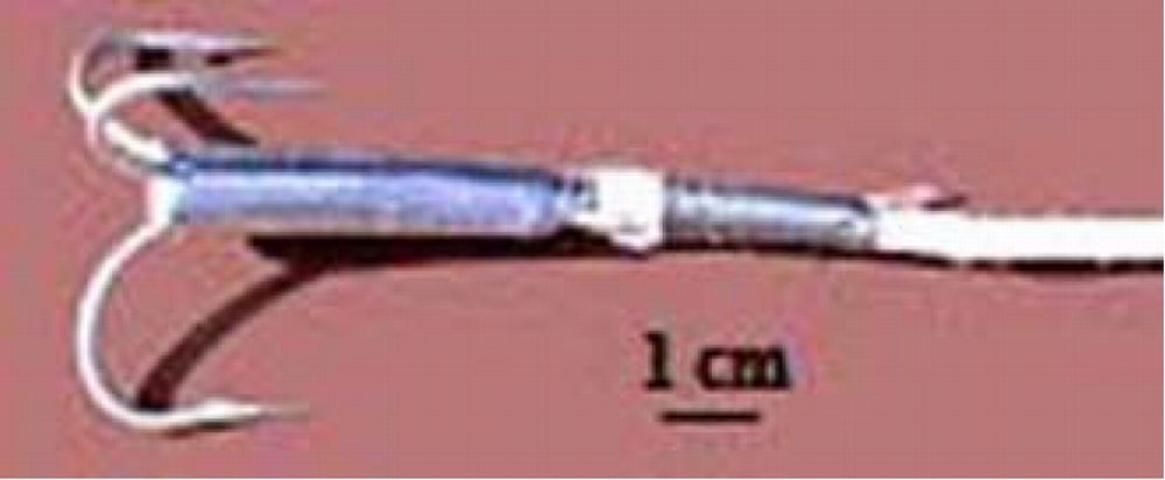
Credit: Michael Cherkiss
Handling Crocodilians
The size of crocodilian that can be brought into the boat is dependent upon boat size and experience of the capture crew. Crocodilians 0.5m total length or larger should have their mouths secured shut prior to handling to prevent them from biting hard objects and breaking their teeth, as well as to keep from biting the investigator. Ropes, nooses (rope and wire), plastic cable ties, and rubber bands can all be used to shut the mouth; duct or electrical tape can secure it closed. Heavy duty rubber bands or strips of inner tube with pieces of line tied to them can be used to secure the mouths of larger animals. After release, when the crocodilian is some distance from the captor, the elastic can be removed by tugging on the line. Under no circumstances should a crocodilian be allowed to escape or be freed with the mouth still secured.
Once the mouth is shut a crocodilian can be further secured by tying or taping its legs together dorsally (for short periods of time only), covering its eyes and ears, and, if necessary, fastening the animal to a board, or other suitable hard object. No safe methods for chemical capture of crocodilians exist; however, animals can be immobilized for measurement, translocation, and surgery (Loveridge and Blake 1987). The muscle relaxant Flaxedil (gallamine triethiodide) has been used successfully on Crocodylus niloticus (Loveridge and Blake 1987; Leslie 1997) and C. porosus (Walsh 1987). Neostigmine methyl sulfate is the antidote for Flaxedil (Loveridge and Blake 1987). It is likely that drug suitability and dosages will differ among species. A pole syringe is the simplest and most effective means of delivering an intramuscular injection. The greatest danger from immobilizing drugs is accidental injection of the person administering them (Buys 1973). Preparation for emergency treatment for accidental injection should be part of any immobilizing procedure.
Animals that are captured, processed, and released quickly show little ill effect from their experience. Crocodilians that have been immobilized or that have struggled in a trap for any length of time need a recovery period. Loveridge and Blake (1987) emphasized the importance of placing crocodilians in shallow water during recovery after using Flaxedil to prevent drowning. Crocodilians that have been handled after trapping should be allowed to recover at their own pace. Crocodilians should not be allowed to get too hot or too cold during handling and recovery.
Literature Cited
Bayliss, P. 1987. Survey methods and monitoring within crocodile management programmes. Pp. 157–175. In Webb, G. J. W., S. C. Manolis, and P. J. Whitehead (eds). Wildlife Management: Crocodiles and Alligators. Surrey Beatty and Sons, Chipping Norton, NSW.
Brandt, L. A., F. J. Mazzotti, J. R. Wilcox, P. D. Barker, G. C. Hasty, and J. Wasilewski. 1995. Status of the American Crocodile (Crocodylus acutus) at a power plant site in Florida, USA. Herpetological Natural History 3: 29–36.
Buys, A. C. 1973. Operator dangers associated with the use of immobilization drugs-accidents and emergency treatment. Pp. 77–83. In Young, E. (ed). The Capture and Care of Wild Animals. Human and Rousseau: Cape Town and Pretoria.
Chabreck, R H. 1963. Methods of capturing, marking, and sexing alligators. Proceedings of the Annual Conference of the Southeast Game and Fish Commission 17:47–50.
Graham, A., and R. Bell. 1969. Factors influencing the countability of animals. East African Agricultural and Forestry Journal 34 (Special Issue): 38–43.
Hutton, J. M., J. P. Loveridge. and D. K. Blake. 1987. Capture methods for the Nile crocodile in Zimbabwe. Pp. 243–247. In Webb, G. J. W., S. C. Manolis, and P. J. Whitehead (eds). Wildlife Management: Crocodiles and Alligators. Surrey Beatty and Sons, Chipping Norton, NSW.
Jones, F. K. Jr. 1966. Techniques and methods used to capture and tag alligators in Florida. Proceedings of the Annual Conference of the Southeast Game and Fish Commission 19:98–101.
Kofron, C. P. 1989. A simple method for capturing large Nile crocodiles. African Journal of Ecology 27:183–189.
Kushlan, J.A., and F.J. Mazzotti. 1989. Population biology of the American Crocodile. J. Herpetol. 23: 7–21.
Leslie, A. J. 1997. The Ecology and Physiology of the Nile Crocodile, Crocodylus niloticus, in Lake St. Lucia, Kwazulu/Natal, South Africa. PhD. Dissertation: Drexel University, Philadelphia, PA.
Loveridge, J.P., and D.K. Blake. 1987. Crocodile immobilization and anaesthesia. Pp. 259–267. In Webb, G. J. W., S. C. Manolis, and P. J. Whitehead (eds). Wildlife Management: Crocodiles and Alligators. Surrey Beatty and Sons, Chipping Norton, NSW.
Magnusson, W. E., J. G. Caughley, and G. C. Grigg. 1978. A double-survey estimate of population size from incomplete counts. Journal of Wildlife Management 42:174–176.
Magnusson, W.E., G.C. Grigg, and J.A. Taylor. 1980. An aerial survey of potential nesting areas of Crocodylus porosus on the West Coast of Cape York Peninsula. Australian Wildlife Resource 7: 465–78.
Magnusson, W. E. 1982. Techniques of surveying for crocodilians. Pp. 389–403. In Crocodiles: Proceedings of the 5th Annual Working Meeting of the Crocodile Specialist Group of the Species Survival Commission of IUCN-The World Conservation Union, Gland, Switzerland.
Mazzotti, F.J. 1983. The Ecology of the American Crocodile in Florida. Ph.D. Thesis. Pennsylvania State University. University Park. PA.
Mazzotti, F.J., and L.A. Brandt. 1988. A method for live trapping wary crocodilians. Herp. Rev. 10:40–41.
McDaniel, J., and L. Hord. 1990. Specialized equipment and techniques used in alligator management and research. Pp. 20-38. In Crocodiles. Proceedings of the 10th Working Meeting of the Crocodile Specialist Group of the Species Survival Commission of IUCN-The World Conservation Union.
McNease, L., N. Kinley, T. Joanen, D. Richard, and D. Richard. 1994. Distribution and relative abundance of alligator nests in Louisiana coastal marshes. Pp. 108–120. In Crocodiles. Proceedings of the 12th Working Meeting of the Crocodile Specialist Group of the Species Survival Commission of IUCN-The World Conservation Union.
Murphy, T. M. Jr., and T. T. Fendley. 1975. A new technique for live trapping of nuisance alligators. Pp. 308–311. In Crocodiles. Proceedings of the Annual Conference of the Southeast Game and Fish Commission.
OBrien, T. 1990. A comparison of 3 survey methods for estimating relative abundance of rare crocodilians. Pp. 91–108. In Crocodiles. Proceedings of the 10th Annual Working Meeting of the Crocodile Specialist Group of the Species Survival Commission of IUCN-The World Conservation Union.
Pacheco, L. F. 1996. Wariness of caiman populations and its effect on abundance estimates. Journal of Herpetology 30:123–126.
Petokas, F. J., and N. M. Alexander. 1979. A new trap for basking turtles. Herpetological Revue 10:90.
Pitman, C. R. S. 1941. About crocodiles. The Uganda Journal. 9:89.
Thorbjarnarson, J. B. 1988. The status and ecology of the American crocodile in Haiti. Bulletin of the Florida State Museum Biological Sciences 33 (1).
Thorbjarnarson, J. B., and G. Hernandez. 1988. Recent Investigations into the Status of Orinoco Crocodiles in Venezuela. Pp. 308–328. In Crocodiles. Proceedings of the 9th Working Meeting of the Crocodile Specialist Group of the Species Survival Commission of IUCN- The World Conservation Union.
Thorbjarnarson, J. B., R. R. Soberon, M A. Tabet, R R. Taragona, and R. Da Silveira. 2000. On the use of camera traps to study crocodilian nesting behavior. Crocodile Specialist Group Newletter. 19 (3):17–18.
Waddle, J.H., K.G. Rice, and H. F. Percival. 2003. From the Field - Using personal digital assistants to collect wildlife field data. Wildlife Society Bulletin. 31:306–309.
Walsh, B. 1987. Crocodile capture methods used in the Northern Territory of Australia. Pp. 249–252. In Webb, G. J. W., S. C. Manolis, and P. J. Whitehead (eds). Wildlife Management: Crocodiles and Alligators. Surrey Beatty and Sons, Chipping Norton, NSW.
Webb, G. J. W., and H. Messel. 1977. Crocodile capture techniques. Journal of Wildlife Management 41:572–575.
Webb, G. J. W., and H. Messel. 1979. Wariness in Crocodylus porosus. Australian Wildlife Research 6:227–234.
Wilkinson, P. M. 1994. A walk-through snare design for the live capture of alligators. Proceedings of the 12th Working Meeting of the Crocodile Specialist Group of the Species Survival Commission of IUCN-The World Conservation Union 2:74–76.
Woodward, A. R., and W. R. Marion. 1979. An evaluation of factors affecting night-light counts of alligators. Proceedings of the Annual Conference of the Southeast Game and Fish Commission 32:291.